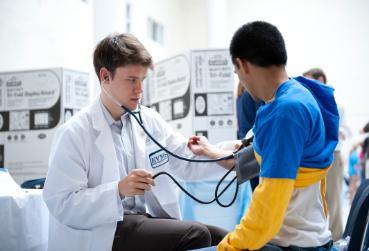 Students who graduate from the EVMS Doctor of Medicine program must be prepared for entry into the practice of medicine within post-graduate medical education training programs. As such, in addition to meeting academic criteria, each applicant to and student in the EVMS Doctor of Medicine program must demonstrate that they possess independent ability, aptitude, and skills to meet the non-academic criteria. These Technical Standards must be met with or without accommodation and are essential for admission to, promotion within and graduation from the EVMS Doctor of Medicine program.
Students who graduate from the EVMS Doctor of Medicine program must be prepared for entry into the practice of medicine within post-graduate medical education training programs. As such, in addition to meeting academic criteria, each applicant to and student in the EVMS Doctor of Medicine program must demonstrate that they possess independent ability, aptitude, and skills to meet the non-academic criteria. These Technical Standards must be met with or without accommodation and are essential for admission to, promotion within and graduation from the EVMS Doctor of Medicine program.
Technical Standards
Observation Skills Technical Standard
Demonstrate sufficient attention and accuracy in observation skills (visual, auditory and tactile) in the lecture hall, laboratory, patient’s bedside and outpatient settings.
Indicators include, but are not limited to, the following examples:
- Accurate observation and participation in the lecture hall, laboratory and clinic with patients at a distance and close at hand, including nonverbal and verbal signals.
- Accurate identification of changes in color of fluids, skin and diagnostic media examinations (including microscopy).
- Accurate visualization, discrimination and interpretation of text, numbers, patterns, graphic illustrations and findings on all imaging modalities and diagnostic procedures.
Communication Skills Technical Standard
Demonstrate effective verbal and non-verbal communication skills with other students, faculty, patients and healthcare providers from different social and cultural backgrounds, varying degrees and types of infirmities and varying cultures and personalities.
Indicators include, but are not limited to, the following examples:
- Clear, efficient and intelligible articulation of English language.
- Legible, efficient and intelligible written English language.
- Ability to prepare and communicate concise oral and written summaries of patient encounters.
- Ability to provide appropriate patient counseling and instruction to patients.
- Record examination and diagnostic results clearly, accurately and efficiently.
Critical Reasoning Skills Technical Standard
Demonstrate critical reasoning skills required to undertake the full curriculum, achieve the level of competency required by the faculty and meet the demands of total patient care in a timeframe appropriate to the clinical or educational situation. These skills include, but are not limited to, intellectual, conceptual, integrative and quantitative abilities.
Indicators include, but are not limited to, these examples:
- Accurate and efficient reading skills (English language).
- Ability to utilize computer technology to access and complete instructional modules and to perform patient care.
- Demonstrate ability to measure, calculate, reason, analyze, integrate and synthesize information.
- Comprehend the spatial relationships of structures (e.g. three-dimensional relationships).
- Demonstrate ability to acquire, retain, assimilate and apply large amounts of complex, technical and detailed information.
- Demonstrate ability to synthesize and apply concepts and information from various disciplines in order to formulate diagnostic and therapeutic plans.
- Demonstrate appropriate judgment in patient assessment, diagnosis, monitoring, evaluation and intervention, including planning, time management and use of resources.
Motor and Sensory Function Technical Standard
Demonstrate sufficient motor and sensory function to perform typical functions of physicians, including, but not limited to, physical examinations, treatment interventions and general care of patients.
Indicators include, but are not limited to, the following examples:
- Functional and sufficient sensory capacity (visual, auditory and tactile) to adequately perform a complete physical examination and elicit information gained from proper use of examination tools and maneuvers (inspection, palpation, percussion and auscultation).
- Execute fine and gross motor movements with sufficient coordination, postural control and hand-eye coordination to safely participate in foundation sciences laboratory sessions, use standard medical/surgical instruments, assess patients, provide patient care and participate in basic diagnostic and therapeutic maneuvers and procedures.
- Execute motor movements that demonstrate safety and efficiency in the various learning settings (i.e., classroom, laboratories and clinical settings, including appropriate negotiation of self and patients in various patient care environments).
- Accurately discern and evaluate various components of the spoken voice (pitch, intensity and timbre), percussive notes and auscultatory findings.
- Physical stamina sufficient to complete the rigorous course of didactic and clinical study, which may include prolonged periods of sitting, standing and/or rapid ambulation.
- Coordination of motor skills necessary to respond to emergency situations quickly and appropriately.
- Ability to perform routine or emergent technical procedures including, but not limited to:
- Complete H&P (adult and pediatric including developmental milestone determination)
- Verbalize understanding of and demonstrate one-provider CPR
- Venipuncture for blood analysis
- Arterial puncture for blood gas analysis
- Nasogastric tube insertion
- Foley catheter insertion
- Pap smear
- Sterile cleaning/debridement of a dirty wound
- Simple suture single-layer laceration repair
- Act as a first assistant for simple surgical or obstetrical procedures
- Apply an extremity splint correctly
- Give an injection/immunization
- Verbalize understanding of and demonstrate proper use of PPE
- Control compressible external hemorrhage with and without a tourniquet
- Maintain an open airway and demonstrate proper use of a bag mask valve
- Establish a peripheral intravenous line
- Apply a sterile dressing to a wound
- Drain a simple subcutaneous abscess
- Perform an ECG
- Have the stamina and physical capability to work continuously for 24-28 hours in a patient care environment
- Verbalize understanding of informed consent and its components, i.e., the intended procedure, benefits, risks and alternatives
Behavioral and Social Attributes Technical Standard
Demonstrate the behavioral and social attributes vital to participation in a professional program and service as a practicing physician.
Indicators include, but are not limited to, the following examples:
- Possess personal qualities that facilitate effective therapeutic interactions (e.g., compassion, empathy, integrity, honesty, benevolence, confidentiality).
- Possess the emotional health required for full utilization of mental faculties (including judgment, orientation, affect and cognition).
- Ability to establish rapport and develop mature and effective professional relationships with faculty, patients, the public and other members of the healthcare team.
- Demonstrate impartial motives, attitudes and values in roles, functions and relationships. Communicate and care for, in a non-judgmental way, persons who differ from oneself and one’s beliefs in a variety of ways, including but not limited to gender, age, race, ethnicity, socio-economic status, culture, creed, military status, sexual orientation and identity and religious or spiritual beliefs.
- Ability to monitor and react appropriately to one’s own emotional needs and responses.
- Display appropriate flexibility, adaptability, composure and emotional stability during periods of high stress or uncertainty associated with didactic and clinical encounters and environments.
- Ability to accurately follow oral and written directions with prompt completion of all responsibilities in the classroom and clinical setting.
- Compliance with standards, policies and practices set forth in the program handbook.
Applicants or students who may have questions regarding these technical standards or who believe they may need to request reasonable accommodation in order to meet the standards are encouraged to consult the EVMS Disability Guide and/or the EVMS Disability Officer.
